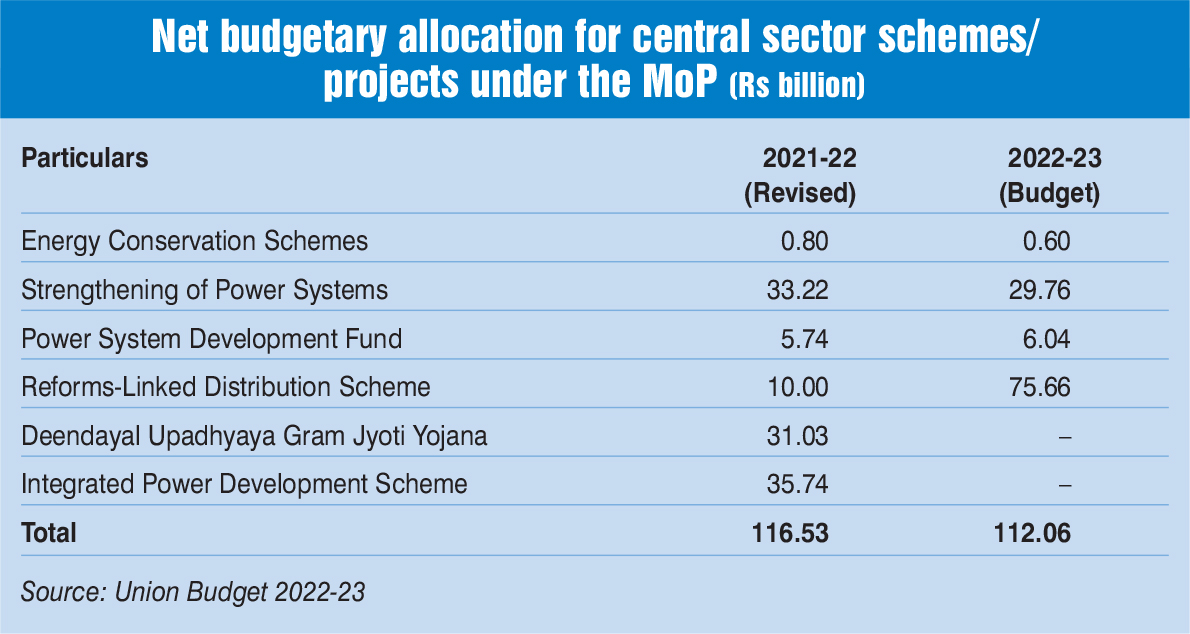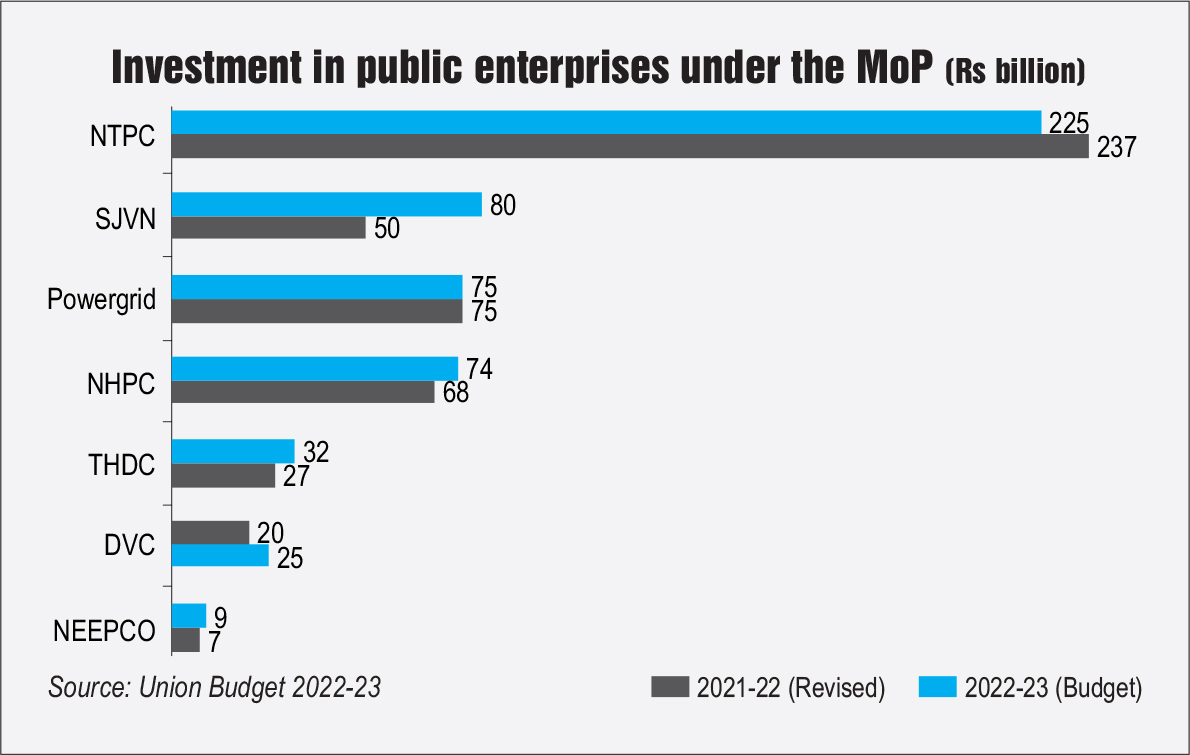 The Union Budget 2022-23 reinforces the country’s commitment towards clean energy transition and mitigating climate change. From an additional allocation of Rs 195 billion under the production-linked incentive (PLI) scheme for solar module manufacturing to the proposed battery swapping policy for electric vehicles (EVs) and co-firing of biomass in thermal power plants (TPPs), the budget fits well with India’s green energy ambitions. Besides, the proposal to issue sovereign green bonds bodes well for mobilising green infrastructure financing.
The Union Budget 2022-23 reinforces the country’s commitment towards clean energy transition and mitigating climate change. From an additional allocation of Rs 195 billion under the production-linked incentive (PLI) scheme for solar module manufacturing to the proposed battery swapping policy for electric vehicles (EVs) and co-firing of biomass in thermal power plants (TPPs), the budget fits well with India’s green energy ambitions. Besides, the proposal to issue sovereign green bonds bodes well for mobilising green infrastructure financing.
Budgetary allocations
Under the Union Budget 2022-23, the Ministry of Power (MoP) has received a net budgetary allocation of Rs 160.74 billion, an increase of 4.91 per cent over the Rs 153.22 billion (revised) allocation in the previous year. The Ministry of New and Renewable Energy has been allocated Rs 69 billion, an increase of around 20 per cent over the net allocation of Rs 57.53 billion in the previous budget. On the other hand, the net budgetary allocation for the Ministry of Coal is Rs 3.93 billion as against Rs 5.34 billion in the previous budget.
A budgetary allocation of Rs 112.06 billion for 2022-23 has been made towards central schemes under MoP, a decline of 3.84 per cent over the revised expenditure in 2021-22. The reforms-linked distribution scheme has been allocated Rs 75.65 billion. An allocation of Rs 29.75 billion has been made for strengthening power systems, including funding of Rs 17 billion towards strengthening of the transmission system in states of Arunachal Pradesh and Sikkim. Apart from this, the Power System Development Fund has been allocated Rs 6.04 billion.
In terms of investment in public enterprises under the MoP, a total of Rs 514.7 billion has been proposed for 2022-23, an increase of 5.03 per cent over the revised estimate of investments in the previous year. NTPC Limited has been allocated Rs 224.54 billion, 5.4 per cent less than the previous year. Meanwhile, the allocations to SJVN Limited have increased by 60 per cent to Rs 80 billion from Rs 50 billion in the previous year.
Key budget proposals
Biomass co-firing: In order to reduce the carbon footprint of TPPs and lower stubble burning in agricultural fields, the central government has proposed 5-7 per cent co-firing of biomass pellets in TPPs. This is expected to result in CO2 savings of 38 million metric tonnes (mmt) annually as well as provide extra income to farmers and create job opportunities for locals.
To recall, in October 2021, the MoP had issued a Policy for Biomass Utilisation for Power Generation through Co-firing in Coal-based Power Plants, which mandated TPPs to use 5-10 per cent biomass along with coal in TPPs. Overall, around 59,000 metric tonnes (mt) of biomass have been co-fired in TPPs as of January 2022, and tendering for another 12 mmt of biomass is under way. Out of this, the biomass co-fired in the NCR region stands at 21,000 mt and tenders floated in the region are about 5.50 mmt. NTPC is leading the utilisation of biomass at its TPPs, having co-fired around 58,000 mt and is tendering for another 10.7 mmt of biomass.
 PLI scheme for solar manufacturing: To facilitate domestic manufacturing for the ambitious goal of 280 GW of installed solar capacity by 2030, the union budget has proposed an additional allocation of Rs 195 billion under the PLI scheme for the manufacturing of high efficiency modules, with priority to fully integrated manufacturing units from polysilicon to solar photovoltaic (PV) modules. With this, the outlay of the PLI scheme for solar modules has been augmented to Rs 240 billion from Rs 45 billion earlier.
PLI scheme for solar manufacturing: To facilitate domestic manufacturing for the ambitious goal of 280 GW of installed solar capacity by 2030, the union budget has proposed an additional allocation of Rs 195 billion under the PLI scheme for the manufacturing of high efficiency modules, with priority to fully integrated manufacturing units from polysilicon to solar photovoltaic (PV) modules. With this, the outlay of the PLI scheme for solar modules has been augmented to Rs 240 billion from Rs 45 billion earlier.
The enhanced PLI scheme budget will strengthen the domestic solar module manufacturing ecosystem and the benefits of the scheme will be extended to several more module manufacturers. It will further push the government’s agenda of Make in India, reduce import dependence and create more jobs.
Battery swapping policy: Considering the constraints of space in urban areas for setting up charging stations at scale, the union budget has proposed to issue a battery swapping policy and interoperability standards. Battery swapping or battery-as-a-service (BAAS) will allow EV owners to replace discharged batteries with charged ones at swap stations. This will address the problem of setting up charging stations and reduce range anxiety among drivers. Following up on the budget announcement, NITI Aayog is expected to release a battery swapping policy for EVs in the next three to four months.
Battery swapping and interoperability will enable a vast energy-operator supply chain, which will help boost EV adoption. It is expected to improve the operational efficiency and financial viability of the EV charging ecosystem. It will also encourage private players to develop sustainable and innovative business models for BAAS, wherein electric two-wheeler and three-wheeler customers need not own the battery, which accounts for about 50 per cent of the total vehicle cost.
Green bonds: The union budget has proposed that as a part of the government’s overall market borrowings in 2022-23, sovereign green bonds will be issued for mobilising resources for green infrastructure. The proceeds will be deployed in public sector projects that help in reducing the carbon intensity of the economy. The sovereign green bonds will also create an ecosystem for greater flow of capital into the green energy sector and improve the prospects of environmental, social and corporate governance (ESG) investing. The global green bond market is expanding at a fast pace, and this will help India access long-term funds at a competitive rate.
Coal gasification: The government has proposed to set up four pilot projects for coal gasification and conversion of coal into chemicals required for the industry. These projects aim to demonstrate the technical and financial viability of coal gasification projects and boost the confidence of the private sector in the segment. The four projects for conversion of coal to clean energy with a private sector capital investment of Rs 301.3 billion will help in achieving the target of 100 mt of coal gasification by 2030.
Energy efficiency: The union budget has proposed to promote energy efficiency and saving measures through the energy service company business model in large commercial buildings. The companies will also facilitate capacity building and create awareness for energy audits, performance contracts, and common measurement and verification protocols.
Economic Survey: Transitioning to clean energy
The Economic Survey 2021-22 lays emphasis on transitioning to clean and renewable energy and its storage as the two main pillars of achieving a net zero carbon economy. The survey points to the fact that the pace of the shift from conventional fossil fuel-based sources to renewable energy sources will determine the extent and mix of investment requirements. It also notes that the transition from conventional fossil fuel-based energy to clean energy as well as battery storage will be more mineral intensive, and it is pertinent to prepare for it on the policy front. Minerals including copper, aluminium, iron, manganese and nickel are critical for developing solar PV, wind and nuclear plants, while lithium and graphite are important for developing energy storage solutions. With the developed countries being the front runners of net zero emission plans, it is important to avoid the risk of being a latecomer. Inelastic supply is already increasing mineral prices, which are likely to shoot up even further in the future. The survey recommends encouraging R&D to speed up the clean energy transition and to develop technology that recycles, reuses and repurposes minerals.
The survey highlights the need for a diversified energy mix (of which fossil fuels are an important part) and simultaneously focusing on building storage for intermittent electricity generation from solar PV and wind farms to ensure on-demand energy supply for the clean energy transition. It points to the recent surge in the prices of natural gas in Europe on account of higher energy demand as well as the cold spells across the region and slower winds for running turbines, which have resulted in lower electricity output. All this reiterates the importance of having a diversified generation mix along with an energy storage solution.
With regard to the projected coal demand in the country, the economic survey notes that as per the Draft National Energy Policy of NITI Aayog, the demand for coal is expected to remain in the range of 1.3-1.5 billion tonnes by 2030, despite the push for renewables. It also points to the several initiatives being taken by coal and lignite-producing PSUs to reduce their carbon footprint, including creating a green cover across 56,000 hectares of land, resulting in a carbon sink of about 500,000 tonnes of CO2 equivalent per year. Apart from this, the PSUs have installed 1,496 MW of renewable capacity as of March 2021 and during the next five years, they have planned to install an additional 5,560 MW of renewable capacity with a substantial carbon offset potential.
 Conclusion
Conclusion
The Union Budget 2022 is in sync with the country’s long-term goals of achieving net zero emissions by 2070, and its clean energy transition targets. Giving the much-needed impetus to e-mobility and domestic manufacturing of solar PV modules, the budget has overall struck a positive chord with industry stakeholders.
Priyanka Kwatra
